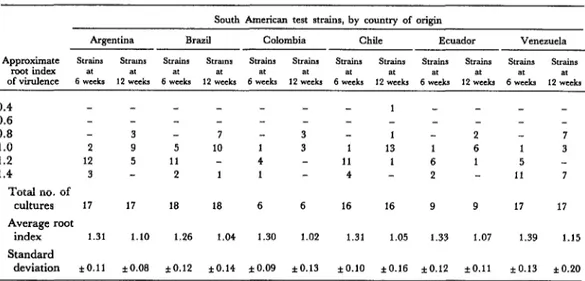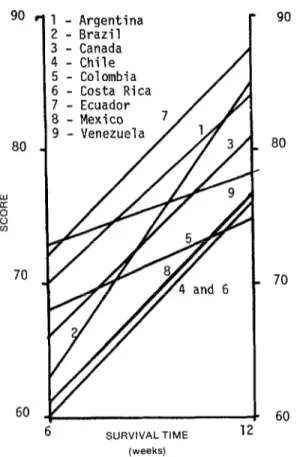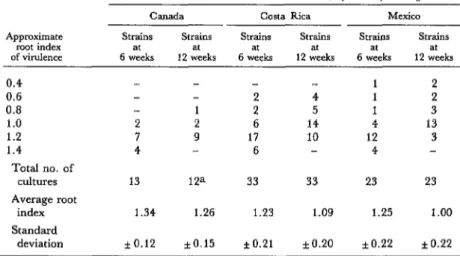BuIl Pan Am Health Organ 17(4), 1983.
VIRULENCE
IN THE GUINEA
PIG OF M. TUBERCULOSIS
STRAINS
ISOLATED
FROM
UNTREATED
PATIENTS
IN
NINE AMERICAN
COUNTRIES1
Isabel N. de Kantor,’
Luis L&ax-o,2 Gladis Amadio,3 Guillermo
Aparicio,d
Lamberto
Blancarte,s
August0 Da Costa Santiago,6 Dolores Kuffo,’
Adalbert
Laszlo,s Juan Ma& Dominguez,g
J. Hugo Reyes Guti&rrez,lO
Maria
T. Valenzuela,”
Pedro Valenzuela,ll
Edgardo Catalini,l*
and Mafalda
Monacci”
E@riences in southern India (7) have suggested that low-vidnce strains of
Mycobacterium tuberculosis could beproducing immunological @ects that inter&e with the protective ejects of BCG vaccine. The stiy reported here sought to a%zrmine the prevalence of similar low-violence strains in nine coun-
tries of the Ameri’caF. Its results suggest that the prevalence of such strains in those countries is relatively low.
Introduction
Studies by Frimodt-Moeller (I), confirmed by Mitchison et al. (2, 3), have shown that ap- proximately 75 per cent of the M. tuberculosis
strains isolated from untreated patients in South India showed less virulence in the guinea pig and greater sensitivity to hydrogen peroxide than did M. tuberculosis strains iso- lated in England (4).
Renewed interest has been focused on these findings as a result of a study of BCG vaccina- tion results conducted in South India, under
the auspices of the Indian Council for Medical Research in collaboration with WHO and the United States Centers for Disease Control (CDC). This study found that the protection supposedly conferred against bacillary pulmo- nary tuberculosis by BCG vaccination could not be demonstrated (5).
Infection of a high percentage ofthe popula- tion in this region of India with the aforemen- tioned low-virulence M. tuberculosis variant
could help to explain the results observed. That is because low-virulence bacilli, though infectious, rarely cause disease soon after they
‘Report of a collaborative project of the Latin Amer- ican Bacteriology Commission (COLABAT), Regional Committee of the International Union against Tubercu- losis; the PAHO/WHO Zoonoses Center (CEPANZO); and the National Laboratory Center of Disease Control in Ottawa, Canada. Also appearing in Spanish in the Boletin de la Oficina Sanitaria Pammcricana, 96(5), 1984.
2Bacteriologist and laboratory technician, respectively, Pan American Zoonoses Center, PAHO/WHO, Casilla de Correo 3092, Correo Central, 1000 Buenos Aires, Ar entina.
f Chief, Regional Tuberculosis Laboratory, Cbrdoba, Ar entina.
f Director, National Institutes of Health, BogotP, Co- lombia.
%hief, Central Tuberculosis Laboratory of Mexico,
Mexico City, Mexico.
6Bacteriologist, Institute of Phthisiology and Pneumo- nology, Federal University of Rio de Janeiro, Rio de Janeiro, Brazil.
‘/Chief, Tuberculosis Diagnosis Department, Institute of Hygiene “L. Izquieta Wrez,” Guayaquil, Ecuador.
*Chief, National Reference Center for Tuberculosis, Laboratory Center of Disease Control, Ottawa, Canada.
9Chief, Central Tuberculosis Laboratory, Maracaibo, Venezuela.
loChief, Central Tuberculosis Laboratory, San Jo&, Costa Rica.
lkhief and former chief, respectively, Institute of Public Health, Santiago, Chile. -
lkhiefs, Provincial Tuberculosis Laboratories, Jujuy and Chaco provinces, respectively, Argentina.
356 PAHO BULLETIN l vol. 17, no. 4, 1983
infect a person. However, such low-virulence strains can induce an immune response com- peting with that induced by BCG vaccination, and they are capable of causing disease later through endogenous reactivation. Therefore, their presence could partly explain the ob- served failure of BCG to confer nrotection
In the Americas, studies on the virulence in guinea pigs of M. tuberculosis strains isolated from untreated patients were carried out in Buenos Aires, Argentina, in 1966 (8) and Bahia, Brazil, in 1970 (9). No attenuated viru-
lence was observed in either study. The pres- ent collaborative study was designed to ana- lyze many sample M. tuberculosis strains, from various countries of the Americas, in order to assess their virulence in guinea pigs and their susceptibility to hydrogen peroxide, with a view to establishing whether low-virulence bacterial variants ‘in these countries could in- terfere with the protective effect of BCG vac- cination.
Materials and Methods
Samples of 159 M. tuberculosis strains iso- lated from patients before treatment in nine countries of the Americas14 were cultured on Lowenstein Jensen medium and sent to the Pan American Zoonosis Center. These strains were tested for niacin production and catalase activity at an ambient temperature of 68’C (10); they were also examined for pigmenta-
13”Whereas BCG vaccination may protect uninfected persons against primary and evolutive tuberculosis, as well as against endogenous reinfection, it cannot be ex- pected to protect uninfected persons if their eventual dis- ease were of the exogenous reinfection type; for at the time of reinfection the level of immunity would be that derived from the primary infection, whether BCG had been given before this or not, so that controls and vac- cinated subjects would have the same risk of disease from endogenous reinfection.” (7).
14Argentina, Brazil, Canada, Chile, Colombia, Costa Rica, Ecuador, Mexico, and Venezuela.
tion, isoniazid (INH) sensitivity, and hydro- gen peroxide sensitivity, as well as for viru- lence in guinea pigs.
The sensitivity to hydrogen peroxide was determined according to the method described by Narayanan Nair et al. (4), wherein the results are expressed as the percentage of bacilli surviving exposure to a 0.02 per cent hydrogen peroxide solution for 90 minutes.
The virulence of the strains in guinea pigs was determined according to the method described by Mitchison et al. (2, 3). Specifical- ly, each strain was inoculated by the subcuta- neous route into four guinea pigs from CEPANZO’s breeding stock. These animals, all short-haired albino males weighing 350- 400 g, each received 1 mg of bacillary mass. The number of bacilli inoculated was con- trolled by enumeration of colonies growing in subcultures.
Of the four animals inoculated with each strain, two were sacrificed six weeks after in- oculation and two were sacrificed 12 weeks after inoculation, if they had not died ear- lier.15 A postmortem e xamination was then performed, and the degree to which the dis- ease was evident in the spleen, liver, lungs, in- oculation site, and associated lymph nodes was scored on a scale of 0 to 100.
This score, divided by the subject animal’s survival time in days (regardless of whether it died or was sacrificed), constituted the strain’s “index of virulence. ” This index was con- verted to a “root index,” following the pro- cedure of Mitchison et al. (2, 3), by taking its square root. The same experiments and pro- cedures used to derive this value for the test strains were also performed simultaneously with the standard M. tuberculosis strains H,,Rv (virulent), H37Ra (avirulent), and Indian 79157, TMC 120 (attenuated virulence in guinea pigs).
de Kantor et al. ’ VIRULENCE OF M. TUBERCULOSIS STRAINS 357
Results
Identifiction Tests
The results of the niacin, catalase, pigmen- tation, and INH sensitivity tests indicated that all but seven of the 159 strains tested were found to consist of catalase-positive M. tubercu- losis sensitive to INH. Of the 28 Mexican strains, one was found to consist of other my- cobacteria belonging to the M. intracelluhre-
s~~ojihceum complex and four were found to be
M. tuberculosis strains that were weakly cata- lase-positive but resistant to INH. Two other M. tuberculosis test strains also proved to be INH-resistant, these being a weakly catalase- positive strain from Costa Rica and a catalase- negative strain from Venezuela.
Sensitivity to Hydrogen Peroxide
In all but 12 cases, at least 50 per cent of the bacilli exposed to a 0.02 per cent hydrogen peroxide solution for 90 minutes survived. The exceptionally sensitive strains included the four INH-resistant strains from Mexico, the INH-resistant strain from Costa Rica, and seven INH-sensitive strains (two from Mexi-
four from Costa Rica, and one from ziile). Th e p ercentages of the INH-resistant strains surviving the exposure ranged from 10 to 30 per cent, while the percentages of the INH-sensitive strains surviving ranged from 15 to 40 per cent.
Virulence in Guinea Pigs
The root indices of virulence obtained for the 152 catalase-positive INH-sensitive M. tuberculosis strains tested are shown in Tables 1 and 2. Most of these strains attained index values at or above the 0.8 level indicating high virulence in guinea pigs.
The results obtained with these 152 strains, grouped by country of origin, in terms of aver- age postmortem scores and guinea pig sur- vival times are shown in Figure 1. In general, low-virulence strains would not be expected to attain markedly higher scores at 12 weeks than at six. Therefore, the positive slope of the mean values charted makes the overall behav- ior of the tested strains look very similar to the behavior of high-virulence strains (with root index values of 0.8 or higher) described by Mitchison et al. (3).
Figure 2 charts relationship between the
Table 1. Root indices of virulence derived for the 83 INH-sensitive M. tubemulos~ test strains isolated from patients in the participating countries of South America.
South American test strains, by country of origin
0.4 0.6
0.8 3 - 7
1.0 2 9 5 10
1.2 12 5 11 -
1.4 3 - 2 1
Total no. of
cultures 17 17 18 18
Average root
index 1.31 1.10 1.26 1.04 Standard
deviation *O.ll f 0.08 *0.12 f0.14
1
3 - 1
1 3 1 13
4 - 11 1
1 - 4 -
6 6 16 16 9 9 17 17
1.30 1.02 1.31 1.05
* 0.09 *0.13 fO.10 *0.16 f0.12 *O.ll f 0.13 * 0.20
2 7
1 6 1 3
6 1 5 -
2 - 11 7
Figure 1. Results with 152 M. tuberculosis test strains, grouped by country of origin, in terms of average postmortem scores and test guinea pig
survival times. Markedly positive slopes indicate high vidence.
80
60
I - Argentina 9 - Chile 5 - Colombia
- Costa Rica 3 - Mexico 7 9 - Venezuela
SURVIVAL TIME
(weeks)
80
60
Figure 2. Results obtained, in terms of postmortem scores and guinea pig survival times, with the three standard M. tuberculosis strains tested and with nine test strains
whose root indices showed relatively low virulence.
3
3 CONTROL CONTROL 4 COSTA RICAN
STRAINS
STRAINS STRAINS
100 100 . .
90 . 90 . 80
80 ._ ._ HWR” HWR”
70 70 . .
60 60 . .
kl kl 8
8 50. 50.
m
m 40. 40.
30
30 .- .- lndlan strain lndlan strain
20 , 20 ,
10 .
10 . H37Ra H& +
+
6 - 12 ! E
1 CHILEAN STRAIN
4 MEXICAN STRAINS
-12 6 .12 6- * -12
de Kantor et al. l VIRULENCE OF M. TUBERCULOSIS STRAINS 359
Table 2. Root indices of virulence derived for the 69 INH-sensitive M. tuberculosis
test strains isolated from patients in the participating countries of North and Central America.
Approximate mot index of virulence
0.4
0.6 0.8
1.0
1.2 1.4
Total no. of cultures Average root
index Standard
deviation
Central and North American test strains, by country of origin
Canada Costa Rica ME&O
Strains Strains Strains Strains Strains Strains
at at at
6 weeks 12 weeks 6 v%zks 12 weeks 6 vi%cs 12 Gzks
1 2
2 4 1 2
1 2 5 1 3
2 2 6 14 4 13
7 9 17 10 12 3
4 6 4
13 12a 33 33 23 23
1.34 1.26 1.23 1.09 1.25 1.00
*0.12 kO.15 f 0.21 *0.20 *to.22 f 0.22
aAll four guinea pigs inoculated with one of the Canadian strains died within six weeks of inoculation. That strain has been eliminated from the “12 week” column because its viru- lence beyond the six-week period could not be tested.
postmortem scores and guinea pig survival times in tests with the three standard strains and with the INH-sensitive strains showing the lowest virulence. Most of the low-viru- lence strains (all four of those from Costa Rica, the one Chilean strain, and two of the four from Mexico) also showed unusual sensi- tivity to hydrogen peroxide.
Conclusions
In general, the virulence values obtained appear comparable to those previously ob- served in British M. tuberculosis strains, taking into account the differences to be expected in experiments carried out by different research- ers using animals with different origins.
Nevertheless, a number of individual strains demonstrated attenuated virulence in guinea pigs (root index values ranging from 0.40 to 0.79). These nine strains constituted 5.9 per cent of the overall sample of 152 INH-sensi- tive strains, 17.4 per cent of the 23 INH-sensi- tive Mexican strains, 12.1 per cent of the 33 INH-sensitive Costa Rican strains, and 6.3 per cent of the 16 Chilean strains. These per- centages of strains exhibiting low virulence are all relatively small compared to the 75 per cent found to exhibit low virulence in South India (‘I, 2, 3). These results suggest that so far as the countries included in the study are concerned, the current probability of low- virulence M. tuberculosis strains competing im- munologically with BCG vaccine are very slight.
SUMMARY
360 PAHO BULLETIN 9 vol. 17, no. 4, 1983
patients in nine countries of the Americas in order to assess the prevalence of low-virulence strains in those countries.
For this purpose, 159 strains were tested for viru- lence in guinea pigs and sensitivity to hydrogen peroxide (another characteristic of the low-viru- lence strains from India), and also for INH sensi- tivity, catalase activity, niacin production, and pig- mentation.
The results indicated that the vast majority of the 152 INH-sensitive strains tested were normally
virulent in guinea pigs. Nine of these strains (17.4 per cent of those from Mexico, 12.1 per cent of those from Costa Rica, and 6.3 per cent of those from Chile) did exhibit low virulence in guinea pigs. However, in all cases the percentage of low- virulence strains was far less than that prevailing in southern India, suggesting that so far as the study countries are concerned, the current likelihood of low-virulence M. tuberculosis strains competing im- munologically with BCG is very slight.
REFERENCES
(1) Frimodt-Moeller, J., K. Mathew, and R. Barton. In: Tuberculosis Association of India. Pro- ceedings of the Thirteenth Tuberculosis Workers’ Confer- ence. New Delhi, 1956, p. 157.
(2,) Mitchison, D. A., J. G. Wallace, A. L. Bhatia, J. B. Selkon, T. V. Subbaiah, and M. C. Lancaster. A comparison ofthe virulence in guinea- pigs of South Indian and British tubercule bacilli.
Tubercle 41:1-X?, 1960.
(3) Mitchison, D. A. The virulence of tubercle bacilli from patients with pulmonary tuberculosis in India and other countries. Bull Int Un Tubex 35: 287-306, 1964.
(4) Narayanan Nair, C., E. M. MacKay- Scollay, K. Ramachandran, J. B. Selkon, S. P. Tripathy, D. A. Mitchison, and J. M. Dickinson. Virulence in the guinea-pig and susceptibility to hydrogen peroxide of isoniazid-sensitive tubercle bacilli from South Indian patients. Tubercle 45:345- 353, 1964.
(5) Baily, G.V.J., R. Narain, S. Mayurnath,
S.R.S. Vallishayee, and J. Guld. Trial of BCG vaccines in south India for tuberculosis prevention. Ind JMed Res 70:349-363, 1979.
(6) World Health Organization. Vaccination against Tuberculosis; Report of an ICMR/WHO Scien- tific Group. WHO Technical Report Series, No. 651. Geneva, 1980.
(7) Pan American Health Organization. BCG vaccination against tuberculosis. Bull Pan Am Health Organ 15(2):188-189, 1981.
(8) Cetrangolo, A., I. N. de Kantor, and M. Di Lonardo. Virulencia para el cobayo de1 Mycobac-
terium tuberculosis aislado de enfermos antes de trata- miento. Rev Asoc Med Arg 80:293-296, 1966.
(9) Silveira, J., and 0. Ferreira. The virulence of M. tuberculosis isolated from tuberculosis patients in Bahia. Pneumvnologie 142:308-311, 1970.
(10) de Kantor, I. N. Baztwiologia de la tuber-
culosis. CEPANZO Monograph 11. Centro


